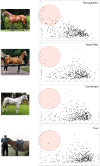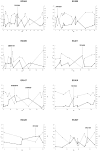A genome scan for positive selection in thoroughbred horses
- PMID: 19503617
- PMCID: PMC2685479
- DOI: 10.1371/journal.pone.0005767
A genome scan for positive selection in thoroughbred horses
Abstract
Thoroughbred horses have been selected for exceptional racing performance resulting in system-wide structural and functional adaptations contributing to elite athletic phenotypes. Because selection has been recent and intense in a closed population that stems from a small number of founder animals Thoroughbreds represent a unique population within which to identify genomic contributions to exercise-related traits. Employing a population genetics-based hitchhiking mapping approach we performed a genome scan using 394 autosomal and X chromosome microsatellite loci and identified positively selected loci in the extreme tail-ends of the empirical distributions for (1) deviations from expected heterozygosity (Ewens-Watterson test) in Thoroughbred (n = 112) and (2) global differentiation among four geographically diverse horse populations (F(ST)). We found positively selected genomic regions in Thoroughbred enriched for phosphoinositide-mediated signalling (3.2-fold enrichment; P<0.01), insulin receptor signalling (5.0-fold enrichment; P<0.01) and lipid transport (2.2-fold enrichment; P<0.05) genes. We found a significant overrepresentation of sarcoglycan complex (11.1-fold enrichment; P<0.05) and focal adhesion pathway (1.9-fold enrichment; P<0.01) genes highlighting the role for muscle strength and integrity in the Thoroughbred athletic phenotype. We report for the first time candidate athletic-performance genes within regions targeted by selection in Thoroughbred horses that are principally responsible for fatty acid oxidation, increased insulin sensitivity and muscle strength: ACSS1 (acyl-CoA synthetase short-chain family member 1), ACTA1 (actin, alpha 1, skeletal muscle), ACTN2 (actinin, alpha 2), ADHFE1 (alcohol dehydrogenase, iron containing, 1), MTFR1 (mitochondrial fission regulator 1), PDK4 (pyruvate dehydrogenase kinase, isozyme 4) and TNC (tenascin C). Understanding the genetic basis for exercise adaptation will be crucial for the identification of genes within the complex molecular networks underlying obesity and its consequential pathologies, such as type 2 diabetes. Therefore, we propose Thoroughbred as a novel in vivo large animal model for understanding molecular protection against metabolic disease.
Conflict of interest statement
Figures




References
-
- Levine M. The origins of horse husbandry on the Eurasian Steppe. In: Levine M, Rassamakin Y, Kislenko A, Tatarintseva N, editors. Late prehistoric exploitation of the Eurasian steppe. Cambridge: McDonald Institute for Archaeological Research; 1999. pp. 5–58.
-
- Jones JH, Lindstedt SL. Limits to maximal performance. Annu Rev Physiol. 1993;55:547–569. - PubMed
-
- Jones JH, Longworth KE, Lindholm A, Conley KE, Karas RH, et al. Oxygen transport during exercise in large mammals. I. Adaptive variation in oxygen demand. J Appl Physiol. 1989;67:862–870. - PubMed
-
- Young LE, Marlin DJ, Deaton C, Brown-Feltner H, Roberts CA, et al. Heart size estimated by echocardiography correlates with maximal oxygen uptake. Equine Vet J. 2002;(Suppl):467–471. - PubMed
-
- Constantinopol M, Jones JH, Weibel ER, Taylor CR, Lindholm A, et al. Oxygen transport during exercise in large mammals. II. Oxygen uptake by the pulmonary gas exchanger. J Appl Physiol. 1989;67:871–878. - PubMed
Publication types
MeSH terms
LinkOut - more resources
Full Text Sources
Other Literature Sources
Miscellaneous

